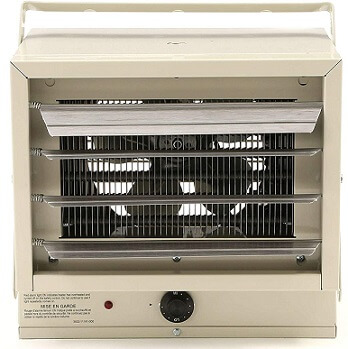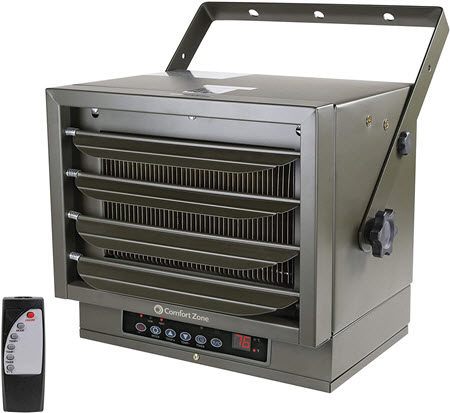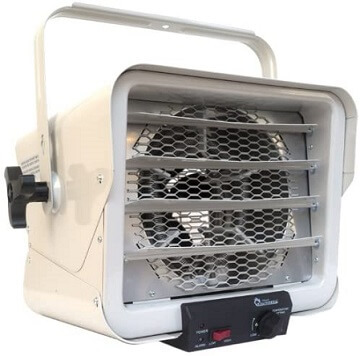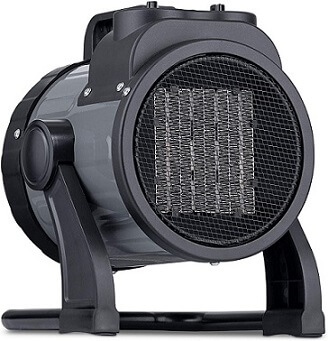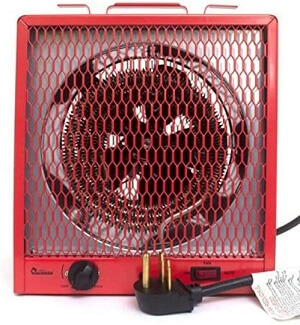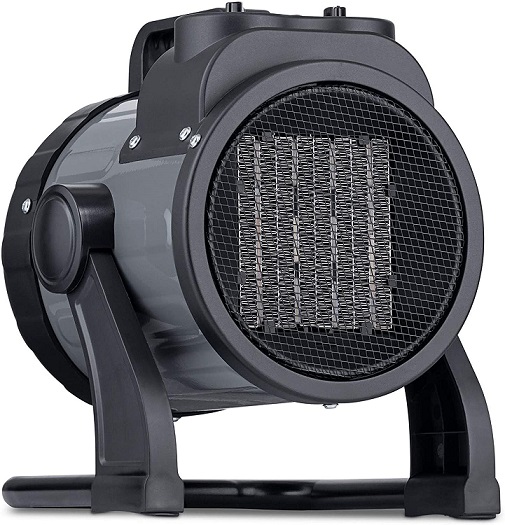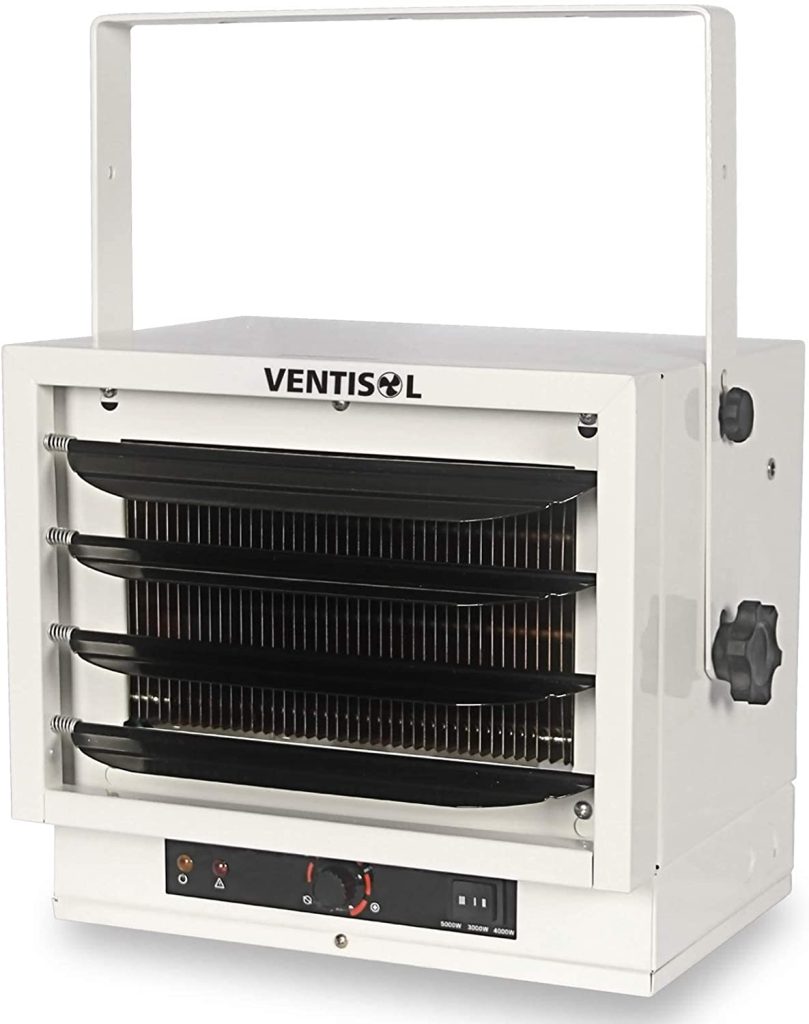For many, garages are more than just a place to park the car or store old boxes – it is a workshop, a hobby room, or even a place to escape and unwind.
As winter’s icy fingers reach out, ensuring this special space remains warm becomes paramount, not only for comfort but also for productivity.
Fortunately, we have a modern solution for this problem – Dedicated Garage Heaters.
These innovative are designed to banish the winter chill, turning even the coldest garage into a warm and welcoming workspace.
But choosing the right one is no walk in the park. Size, wiring, installation, and safety are just a few of the many aspects to ponder over.
But don’t worry, this article is your roadmap, guiding you through the Best Garage Heaters in today’s market. Beyond that, we have also provided an in-depth “Buying Guide” to equip our readers with adequate information to make a wise decision.
Also Check: Best Portable Car Heater
7 Best Garage Heaters Chart
| Garage Heater | Award | Heating Capacity | Power Rating | Buy Now |
|---|---|---|---|---|
| Fahrenheat Heater for Garage | Best for Large Spaces | 17000 BTU | 5000 watts | Check On Amazon |
| Comfort Zone Ceiling Mount Heater | Most Durable | 25000 BTU | 7500 watts | Check On Amazon |
| Dr. Infrared Dr 966 Garage Heater | Best Overall | 20500 BTU | 6000 watts | Check On Amazon |
| NewAir Electric Portable Garage Heater | Portable | 5120 BTU | 1500 watts | Check On Amazon |
| Dr. Infrared Heater Dr 988A Garage Shop Heater | High Heating Capacity | 19100 BTU | 5600 watts | Check On Amazon |
| NewAir NGH160GA00 Heater | Budget-Friendly | 9000 BTU | - | Check On Amazon |
| VENTISOL Electric Garage Heater | Efficient & Quiet | 17065 BTU | 5000 watts | Check On Amazon |
7 Best Garage Heaters Reviews
1.Fahrenheat Garage Heater
Key Features:
- Heating Output (BTU): 17000 BTU
- Heating Type: Electric
- Fuel Source: Electricity
- Item Dimensions: 12.5″D x 12.4″W x 14″H
- Warranty: 1 year
With an adjustable thermostat, the heater provides a broad temperature range from 45 °F to 135 °F. This allows users to customize the warmth as per their comfort, making it suitable for varying weather conditions.
The high-level cutout feature ensures that the heater automatically shuts off to prevent overheating. Once the temperature returns to a safe level, the heater reactivates, ensuring consistent warmth without compromising on safety.
The heater comes with a ceiling mounting bracket, facilitating both vertical and horizontal placements. Coupled with adjustable louvers, users can direct the heat exactly where they want, ensuring optimal warmth distribution.
Built for heavy-duty applications, this model is ideal for spaces like garages, workshops, or warehouses. Its fan, with a speed of 1350 RPM, ensures effective ventilation, spreading the generated heat evenly across the room.
What Are Customers Saying:
Users have consistently praised the Fahrenheat FUH Garage Heater for its efficiency and performance. Many appreciate its easy installation process, facilitated by the mounting bracket. But some users might find the 1350 RPM fan a bit noisy, especially in quieter environments or during night-time usage.
2. Comfort Zone Garage Heater
Key Features:
- Heating Output (BTU): 25,000 BTU
- Heating Type: Fan-Forced Ceiling Mount Heater
- Fuel Source: Electric
- Item Dimensions: Not specified in the provided details
- Warranty: 1-year
The Comfort Zone CZ230ER is masterfully engineered for ceiling mounting, which optimizes space utilization. This hard-wired installation ensures that your floor remains clutter-free, making it an ideal choice for packed environments like warehouses, garages, and storage areas.
Crafted with heavy gauge steel, the heater promises durability and resilience, especially in settings that witness significant temperature variations. This rugged construction stands as a testament to its longevity, even in the most demanding environments.
Adjustable louvers and a variable mounting angle grant users the flexibility to direct warmth precisely where it is needed, ensuring maximum efficacy. This fan-forced design aids in uniformly distributing the heat across the space.
With an intuitive digital thermostat, users can customize the temperature settings to their preference. A 12-hour timer further enhances convenience, and the inclusion of a full-function remote control ensures you can tweak settings from a comfortable distance.
The built-in overheat protection sensor guarantees that the device switches off automatically upon detecting unsafe temperatures, ensuring the unit’s safety and longevity.
What Are Customers Saying:
Customers often laud the Comfort Zone CZ230ER for its impressive heating capacity, particularly praising the 25,000 BTU output that efficiently warms large spaces. The steel construction is often cited as a significant advantage, with users noting the heater’s resilience and long-lasting performance. While the unit scores high on efficiency and design, a few users have expressed a desire for clearer installation instructions.
3. Dr. Infrared Dr 966 Garage Heater
Key Features:
- Heating Output (BTU): 20,500 BTU
- Heating Type: Electric Hardwired Shop Garage Commercial Heater
- Fuel Source: Electric
- Item Dimensions: 14.5″ Height x 13″ Width x 14.5″ Depth
- Warranty: 1-year
With dual power settings, the Dr. Heater DR966 offers versatility in its operation. Users can choose between a high-power mode of 6,000 watts for intense heating or a low-power mode of 3,000 watts for milder warmth. The heater incorporates a dynamically designed 8-inch fan that ensures maximum airflow with minimal turbulence and noise.
Designed with spiral steel metal sheath electric heating elements, the DR966 promises uniform heat and an extended service life. This ensures consistent warmth and longevity of the unit. The heater is equipped with a totally enclosed, thermally protected, heavy-duty ball-bearing motor. This motor is permanently lubricated, translating to reduced maintenance and enhanced life expectancy.
A rugged stamped steel front cover features five-way adjustable louvers. This allows users to direct airflow with precision, ensuring heat is directed to where it is needed the most. With both wall and ceiling mounting brackets included, the heater offers flexibility in installation. This is further complemented by its finished look in a sleek gray epoxy paint.
What Are Customers Saying:
Users have consistently praised the Dr. Heater DR966 for its powerful heating performance, particularly lauding its ability to warm up large spaces efficiently. However, some customers have mentioned challenges with the installation process, particularly in the absence of a power cord included with the unit. A few have also expressed a desire for clearer instructions or a more straightforward installation method.
4. NewAir Garage Heater
Key Features:
- Heating Output (BTU): Not Specified (but has a capability to heat up to 160 square feet)
- Heating Type: Ceramic Electric Heater
- Fuel Source: Electric
- Item Dimensions: 10.3″ Height x 8.6″ Width x 8.6″ Length; Weight: 4.4 Pounds
- Warranty: 1-year limited
Built to last, the NewAir Portable Garage Heater showcases a rugged exterior shell, ensuring it can withstand tough conditions in a workshop or garage environment. The heater is not just lightweight and compact but also sports an integrated handle for ease of movement. The plug-and-play design, compatible with a standard 120-volt outlet, ensures that warmth is just a plug away.
Merging the power of a 200 CFM fan with the efficiency of a ceramic heating plate, the heater ensures a consistent stream of warmth. The fan-assisted design prevents cold spots, distributing heat evenly.
The tilting head feature is a unique addition that facilitates spot heating for up to 160 square feet. With dual heat settings, users have the flexibility to control the heating intensity based on their needs. The adjustable thermostat allows for precise temperature control.
Ensuring user safety is paramount with this garage heater. It boasts an internal thermostat and an automatic shut-off function to prevent overheating. Moreover, the exterior remains cool to the touch, minimizing burn risks.
What Are Customers Saying:
Customers appreciate the NewAir NGH160GA00 for its fast-heating capabilities, especially noting its efficiency in medium-sized garages or workshops. However, a drawback pointed out by some users is the lack of a specified BTU rating, making it challenging to compare its heating capacity with other models in the market. A few have also mentioned that while it works exceptionally for smaller areas, its efficacy may reduce in larger spaces or extremely cold conditions.
5. Dr. Infrared Dr 988A Garage Heater
Key Features:
- Heating Output (BTU): Approximately 18,500 BTU
- Heating Type: Infrared
- Fuel Source: Electric
- Item Dimensions: 12″ Width x 12″ Depth x 16″ Height
- Warranty: 1-year
The Dr. Infrared Heater DR-988 is a powerhouse when it comes to heating large spaces. Its advanced dual heating system can heat up a large room quickly and uniformly, ensuring there are no cold spots.
With a built-in thermostat that can be adjusted from high to low, users have the flexibility to set their preferred temperature. The heater will automatically maintain the set temperature, making it energy efficient and ensuring continuous warmth.
The heater is designed with a plethora of safety features. It boasts an electronic thermostat ranging from 37 to 113 degrees and an overheat protection mechanism. The intake and discharge grills are finger-proof, ensuring users’ safety during operation. It also has a high temperature heating limit feature for added security.
This unit is not just another heater; it’s made specifically with garages, workshops, and basements in mind. Its compact design is complemented by a built-in carry handle, maximizing portability. The built-in cord storage ensures that your workspace remains tidy.
Dr. Infrared Heater is a known brand in the heating industry, especially for its infrared heaters. The DR-988 model ensures you get the high quality and durability the brand is renowned for. It also comes with both UL and C-UL safety certifications.
What Are Customers Saying:
Users have expressed their satisfaction with the Dr. Infrared Heater DR-988’s heating efficiency, noting that its ability to quickly heat large spaces without leaving cold spots is impressive. However, a few customers have pointed out that the fan can be a bit noisy for some, especially when used in quieter environments. Another drawback mentioned is the specific plug requirement (NEMA #6-30P 250V 30A), which means some users might need to install a new outlet or use an adapter.
6. NewAir NGH160GA00 Garage Heater
Key Features:
- Heating Output (BTU): Varies
- Heating Type: Ceramic
- Fuel Source: Electric
- Item Dimensions: 8.6″D x 8.6″W x 10.3″H
- Warranty: 1 year
Armed with a ceramic heating plate and a robust 200 CFM fan, the NewAir Portable Garage Heater ensures quick and even heat distribution. Its ability to deliver a steady stream of warm air reduces wait time, allowing for immediate comfort.
Built for demanding workspaces, this heater boasts a rugged shell designed to withstand the tough conditions typically found in garages and workshops. Its durability ensures longevity even in rigorous environments.
It comes with an internal thermostat that regulates temperature and an automatic shut-off mechanism to prevent overheating. Additionally, the heater remains cool to the touch, ensuring users remain safe during operation.
The heater comes equipped with a tilting head, enabling users to direct heat exactly where they need it, covering up to 160 square feet of space. The two heat settings offer flexibility, allowing users to adjust the warmth level to their preference.
This heater is designed with user convenience in mind. Its lightweight construction, combined with an integrated carry handle, makes it easy to transport. The 120-volt plug ensures compatibility with standard outlets, emphasizing its plug-and-play nature. When not in use, its compact design ensures hassle-free storage.
What Are Customers Saying:
Customers appreciate the NewAir NGH160GA00 Portable Garage Heater for its quick heating capability and effective warmth distribution. However, a drawback mentioned by some customers is the absence of specific BTU and dimension details, making it a bit challenging to determine its suitability for larger spaces.
7. VENTISOL Garage Heater
Key Features:
- Heating Output (BTU): 17,065 BTUs
- Heating Type: Fan-forced Ceiling Mounted
- Fuel Source: Electric
- Item Dimensions: 13.98 x 10.83 x 12.8 inches
- Warranty: 1-year
The VENTISOL Garage Heater offers an impressive heating output in a compact design, ensuring a warm and comfortable workspace during cold winter days. Its low noise operation ensures that your daily activities, whether resting, reading, or working, remain undisturbed, providing a peaceful environment.
Crafted with a heavy-gauge steel body, the heater promises durability and longevity. Although the power cord is not included, once professionally hardwired, turning your cold workspace into a cozy area becomes a breeze.
The heater’s louvers and adjustable mounting bracket offer flexibility in directing the airflow to your desired location. With its ceiling-mounted design, not only is space maximized, but it also ensures even distribution of warmth across the room.
Equipped with dual knob controls, adjusting the heater’s temperature is straightforward. A power selection switch lets users pick their preferred heating output, from 3000W to 5000W, tailoring the warmth to their needs.
With a built-in digital thermostat, users can easily tailor the heater’s temperature to their room’s needs. In addition, the heater is equipped with an overheat protection sensor, ensuring that the unit shuts off automatically if internal temperatures rise too high, thus preventing any potential damage. Furthermore, its ETL certification stands as a testament to its safety standards.
What Are Customers Saying:
Users have expressed satisfaction with the VENTISOL Garage Heater’s efficiency and its ability to heat small to medium rooms effectively. However, a common drawback highlighted by some customers is the absence of a power cord included with the heater, necessitating additional expenses and potentially complicating the installation process.
What to Consider While Purchasing A Garage Heater?
Navigating the world of garage heaters can be a daunting task, especially with the myriad of options available in today’s market. However, understanding key features and considerations can simplify the process. Here is a comprehensive buying guide to help you select the ideal garage heater:
1. Types of Garage Heaters
Based on their heating methodology, garage heaters are categorized into three different options that include forced, convection, and radiant.
Each of these heaters comes with its unique set of attributes, fitting different scenarios and user needs. Knowing their working mechanisms, applications, and pros & cons can significantly aid in making a tailored choice for your garage.
a. Forced Air Garages
These heaters use a fan to circulate hot air blasts into the space. Depending on the model, they can be powered by electricity, natural gas, or propane. They are suitable for quickly heating large spaces. Gas-powered models, especially, are ideal for areas where natural gas or propane is more economical than electricity.
Pros:
- Rapid heating.
- Even distribution of warmth.
- Gas models might offer cost-effective operation in the long run.
Cons:
- Can stir up debris due to the fan.
- Might feel too intense if directed straight at a person.
- Some models may release fumes or water vapor, necessitating good ventilation.
b. Convection Garage Heaters
These heaters warm air within their unit (often using water- or oil-filled radiators). The warm air then rises naturally without the assistance of a fan. Ideal for uniformly heating entire rooms or spaces, leveraging the natural circulation of air. They offer flexibility; some are portable, while others, like baseboard convection heaters, are designed for mounting.
Pros:
- Provides steady, room-wide warmth.
- Often more affordable compared to other heater types.
- Quieter operation due to the lack of a fan.
Cons:
- Takes longer to achieve the desired temperature.
- Might not provide the intense immediate warmth that some users prefer.
c. Radiant Garage Heaters
These heaters emit infrared heat, using polished reflectors to direct this warmth. They function similarly to sitting in front of a campfire, providing direct heat to objects and people in their path. They are perfect for workspaces, especially woodworking, as they will not stir up dust. They provide spot heating or, in the case of larger units, can heat an entire space.
Pros:
- Immediate, direct warmth.
- Steady heating without the need to circulate air.
- Does not disturb airborne particles, making it cleaner for certain tasks.
Cons:
- May not uniformly heat a space unless it is a larger unit.
- Objects or areas out of the heater’s direct path might not receive as much warmth.
2. Fuel Source
When browsing for a garage heater, consumers are presented with an array of energy choices. Although electricity, propane, and natural gas are the most prevalent fuel sources, one can also find heaters powered by diesel and kerosene.
The ideal fuel source for a garage heater hinges on various factors including the size of the space, portability needs, operational costs, and available ventilation. Each source brings a unique set of benefits and challenges to consider. We have mentioned clear data on the commonly uses fuel sources below for your references.
a. Electric
Electric heaters convert electrical energy into heat. The electricity flows through a resistive element, and as it meets resistance, it produces heat, which is then circulated or radiated into the room.
They are especially suitable for smaller spaces where rapid and efficient heating is needed. Given the absence of fumes or combustion, they can be used in enclosed settings without the need for ventilation.
Pros:
- Simple Installation: Typically, electric heaters only require a suitable electrical outlet, making their setup straightforward.
- Portability: Many models are designed to be lightweight and easy to move, making them versatile for different spaces or needs.
- Safety: No combustion means no risk of gas leaks or carbon monoxide.
Cons:
- Operational Costs: Depending on electricity rates, these heaters might be more expensive to operate compared to gas-based solutions.
- Limited Heating Capacity: They might not be as effective for very large spaces or extremely cold conditions.
b. Natural Gas
These heaters burn natural gas to produce heat. The combustion process releases warm air which is then circulated into the space. It is ideal for larger garages or workspaces where sustained, powerful heating is required.
Pros:
- Economical Operation: Natural gas is often cheaper than electricity, making these heaters more cost-effective over time.
- High Heating Capacity: Can produce a significant amount of heat, suitable for larger spaces.
Cons:
- Ventilation Requirement: Combustion produces byproducts like carbon monoxide, necessitating proper ventilation to ensure safety.
- Installation Complexity: Typically requires professional installation, especially to connect to a home’s gas line.
c. Propane
These heaters burn propane from a connected tank to generate heat, which is then radiated or circulated into the space. They are useful for settings where natural gas is not available, or for temporary heating needs where portability is key.
Pros:
- Portability: Many propane heaters are designed to be movable, letting users bring warmth wherever it is needed.
- Powerful Heating: Like natural gas, propane can produce intense heat, making it effective for chillier conditions.
Cons:
- Fuel Monitoring: Users must keep an eye on propane levels to ensure continuous operation.
- Ventilation Needs: Burning propane releases combustion byproducts, so proper ventilation is essential.
3. Heating Capacity (BTUs)
The next factor to consider while analyzing garage heaters is the heating capacity. Because an over-performing heater can create uncomfortable environment while under-performing heater is not effective in heating up the room.
BTU, or British Thermal Unit, is a standard unit of energy used to quantify the amount of heat a heater can produce. When selecting a garage heater, it is pivotal to match the heater’s BTU output to the volume of the space you intend to warm, ensuring efficient and effective heating.
Here’s a detailed look at how to calculate the right heating capacity:
To ascertain how many BTUs are required, first calculate the volume of your garage in cubic feet. This is done by multiplying its length, width, and height.
Volume = Length × Width × Height
For example, a garage measuring 20 feet in length, 15 feet in width, and 8 feet in height, then the total volume is calculated as below.
Volume = 20′ × 15′ × 8′ = 2,400 cubic feet
Once you have the volume, you can then match it to a heater’s BTU output to ensure efficient heating. While exact BTU needs can vary based on factors like insulation and external temperatures, a general rule of thumb can provide a starting point for selection.
Below is a table representing common garage sizes and heater capacity.
| Garage Size (sq. ft) | Power in Watts | Power in BTUs |
| 240 (1 car garage) | 2400 W | 8200 BTU |
| 440 (2 car garage) | 4400 W | 15000 BTU |
| 620 (3 car garage) | 6200 W | 21200 BTU |
| 800 (4 car garage) | 8000 W | 27300 BTU |
| 1000 | 10000 W | 34100 BTU |
| 1500 | 15000 W | 51200 BTU |
Some of the factors to consider while adjusting the BTU are
- Insulation: A well-insulated garage retains heat better, possibly reducing the required BTU capacity.
- External Temperatures: If you live in an exceptionally cold region, you may need a heater with a higher BTU rating to achieve desired warmth.
- Frequency of Opening: Frequently opening the garage door will let in cold air, potentially demanding a heater with a higher BTU output.
Remember that, it is always wise to slightly overestimate than underestimate to account for unexpected cold spells or other factors.
4. Safety Features
Another major factor to consider is the safety features. Recognizing the potential risks associated with heaters, manufacturers have incorporated a range of safety features to ensure not only effective heating but also peace of mind for users. Here’s a deep dive into these safety measures:
a. Overheat Protection
It safeguards against both internal malfunctions and the risk of external damage, ensuring the longevity of the heater and safety of the surroundings.
b. Cool-Touch Exteriors
This is especially crucial in environments where children or pets might be present, preventing accidental burns upon contact.
c. Automatic Shut-Off Systems
It acts as a secondary line of defense against unexpected situations, enhancing the safety quotient of the heater.
d. Tip-Over Protection
Given that garage spaces can be bustling with activity, this feature is vital to prevent fires or damage should the heater be accidentally bumped or knocked over.
e. Thermostat Control
Allows users to set a desired temperature, ensuring the heater operates only until that temperature is reached. This not only conserves energy but also minimizes the risk of overheating.
f. No Flame Protection
This acts as a frontline defense against gas leaks or accumulation, which could be hazardous.
Before making a purchase, always ensure the heater you choose is equipped with these features for an optimum blend of warmth and safety.
5. Installation
The installation process for garage heaters typically ranges from straightforward to moderately complex, depending on the heater type. Portable heaters are user-friendly; simply place them in the desired location and supply the necessary power or fuel. In contrast, ceiling- and wall-mounted heaters require more meticulous installation due to the hardware involved. Not all models come with mounting brackets, but manufacturers typically provide detailed guidelines.
6. Noise Levels
In many homes, garages serve as work or hobby spaces. For those valuing peace during projects, the noise level of a heater becomes crucial. Some garage heaters, especially certain forced-air models, can be particularly loud. It is essential to check decibel ratings when provided to ensure the chosen heater complements your need for tranquility and does not disrupt your tasks.
7. Ventilation
Ventilation is paramount when using gas or propane heaters, which emit carbon monoxide—an odorless, potentially lethal gas. It is essential to have proper garage ventilation to prevent gas buildup. Ensure adequate airflow and consider adding carbon monoxide detectors for extra safety. Before choosing such a heater, evaluate your garage’s ventilation to protect your health.
8. Additional Features
- Heat Settings: Choose heaters with adjustable settings to match varying indoor conditions. Ideally, models with thermostats or dual settings allow flexibility; for instance, you can opt for low heat on spring mornings and high heat during cold winter nights.
- Power Cord or Hose Length: For electric heaters, consider cord length for placement flexibility. A typical 6-foot cord provides reasonable portability. Some propane heaters include a longer, 10-foot hose, offering more setup options by connecting to the gas tank.
- Carrying Handle: An essential feature that enhances portability. Handles allow for easy movement and provide protection against burns when relocating a hot heater.
- Adjustable Louvres: Found in certain fan-forced heaters, adjustable louvres direct heat precisely where needed, optimizing warmth distribution.
- Programmable Thermostats: These let users set a desired temperature either via a remote or electronic keypad. The heater then maintains the selected temperature, ensuring consistent warmth.
- Remote Controls: Enhance convenience by allowing you to adjust heater settings from anywhere in your garage, eliminating the need for manual adjustments.
- Oscillation: Common in portable heaters, this feature, sometimes seen in wall-mounted units with oscillating vents, ensures even heat distribution. With up to 180° rotation, these heaters spread warmth efficiently throughout the space.
9. Energy Efficiency
Selecting heaters with a high-efficiency rating guarantees optimal warmth for the energy consumed, making them more cost-effective in the long run. It is a smart investment that delivers maximum heat output for every unit of energy used.
10. Warranty
A robust warranty is indicative of a manufacturer’s confidence in their product. It not only offers peace of mind but also ensures protection against unforeseen malfunctions or defects, potentially saving significant expenses and inconvenience down the line. Always prioritize heaters backed by a solid warranty.
Safety Tips to Consider While Using Garage Heaters:
Using garage heaters can be a great way to maintain a comfortable environment, but it’s essential to prioritize safety. Here are some crucial safety tips to consider:
- Ventilation: If you are using gas or propane heaters, ensure adequate ventilation to prevent carbon monoxide buildup.
- Keep Flammable Materials Away: Ensure the area around the heater is free from flammable materials such as gasoline, paints, and cleaning agents.
- Use Carbon Monoxide Detectors: If using gas-powered heaters, install a carbon monoxide detector as a precaution.
- Regular Inspection: Regularly check for signs of wear or damage on electrical cords, gas lines, and the heater itself.
- Stable Positioning: Ensure the heater is on a stable surface, especially if it’s portable, to prevent tipping.
- Never Block the Heater: Avoid placing objects directly in front of the heater, which can obstruct airflow.
- Follow Manufacturer’s Instructions: Always read and adhere to the manufacturer’s guidelines for installation, operation, and maintenance.
- Don’t Use Extension Cords: If using an electric heater, plug it directly into an outlet. If an extension cord is unavoidable, ensure its heavy-duty and rated for the heater’s electrical load.
- Automatic Shut-Off Feature: Opt for heaters that come with safety features like overheat protection and tip-over shut-off.
- Keep Away from Water: Never use or place a heater where it can meet water or dampness.
- Child and Pet Safety: Keep heaters out of reach of children and pets, and educate them on the potential dangers.
- Regular Maintenance: Clean filters and inspect components regularly for optimal performance and safety.
- Turn Off When Not in Use: Always turn off the heater when leaving the garage or before going to sleep.
By following these safety tips, you can ensure a warm, comfortable, and safe environment in your garage during the colder months.
Best Garage Heaters – FAQs
Ans: Yes, when used correctly. Ensure proper ventilation, especially for gas and propane heaters, and consider safety features like tip-over and overheat protection.
Ans: Some models, especially those connected to gas lines or hardwired electric models, may require professional installation. Always follow the manufacturer’s guidelines.
It is simple and easy to install garage heaters and all its models won’t require installation. Some electric heaters require hardwired, which is connected to household wiring with a cable. Other electric heaters are plugged into a standard 120V outlet.
While wall- and ceiling-mounted models offer brackets and mounting hardware for its perfect installation. Propane heaters must be connected to a liquid propane tank with a hose and regulator. Natural gas heaters are directly connected to the existing household’s gas line.
Ans: While many garage heaters are versatile, always check the manufacturer’s recommendations. Ensure the chosen space is appropriate in size and has proper ventilation.
Ans: Regularly check for wear or damage, clean filters, and inspect components. Frequency depends on usage and specific heater models.
Ans: For safety reasons, it is best to turn off the heater when not in use. Some heaters come with programmable thermostats that can regulate temperatures even when you are not present.
Ans: It is recommended to plug the heater directly into an outlet. If an extension cord is necessary, ensure it’s rated for the heater’s electrical load. Remember to always consult the user manual and manufacturer’s guidelines for any specific questions related to your garage heater model.
Ans: It’s best to turn off and unplug the heater before moving. If it is hot, wait for it to cool down or use the provided handles to avoid burns.
Ans: No. Always maintain a safe distance between the heater and any flammable materials to prevent fire risks.
Ans: The lifespan of a garage heater varies based on the model, usage, and maintenance. With proper care, many heaters can last for several years.
Ans: While possible, changing the thermostat might void warranties. Consult an electrician first.
Ans: If you frequently use your garage for activities other than parking, a heater can be valuable for comfort.
Ans: Yes, but expect more heat loss and potentially higher energy costs.
Ans: Many electric garage heaters require hardwiring, but some come with outlet plugs for more flexibility. Choose based on your needs.
Ans: Typically, a 3000-watt electric or an 18000 BTU gas heater should suffice, but it depends on the local climate.
Ans: Infrared heaters offer near 100% efficiency, but operation costs can be higher than gas models.
Ans: Propane heaters can be a cost-effective choice after ensuring proper insulation and ventilation.
Ans: Smaller heaters might consume more electricity than expected. Always check efficiency ratings before purchase.
Ans: No, this can pose fire risks and is an unnecessary energy expenditure.
Ans: When installed and vented correctly, propane heaters can be safe. Always follow manufacturer guidelines.
Conclusion
Choosing the best garage heater is essential for those who view their garage as more than just a storage or parking space. It ensures a comfortable and efficient workspace, especially during colder months.
From safety features to efficiency ratings, various factors play a critical role in your decision-making process. Whether you prefer an electric, propane, or natural gas heater, it is crucial to select a model tailored to your garage’s size, ventilation, and insulation conditions.
According to our experts, below are our top recommendations when it comes to best garage heaters.
- The NewAir Garage Heater stands out for budget-conscious buyers. Even with its affordable price, it boasts an impressive heating capacity of 5120 BTU and operates at a mere 1500 watts, showcasing its efficiency.
- For those seeking power and robust performance, the Dr Infrared DR966 Garage Heater is an excellent choice. Its formidable 20500 BTU heating capacity is perfect for larger spaces.
- If durability coupled with high heating capability is a priority, the Comfort Zone Garage Heater is hard to beat. With a peak power rating of 7500 watts and a remarkable 25000 BTU per hour heating capacity, it is versatile enough for garages, workshops, warehouses, and other expansive areas with high ceilings.
We would love to hear from you! Drop your feedback or any queries in the comments section below.

